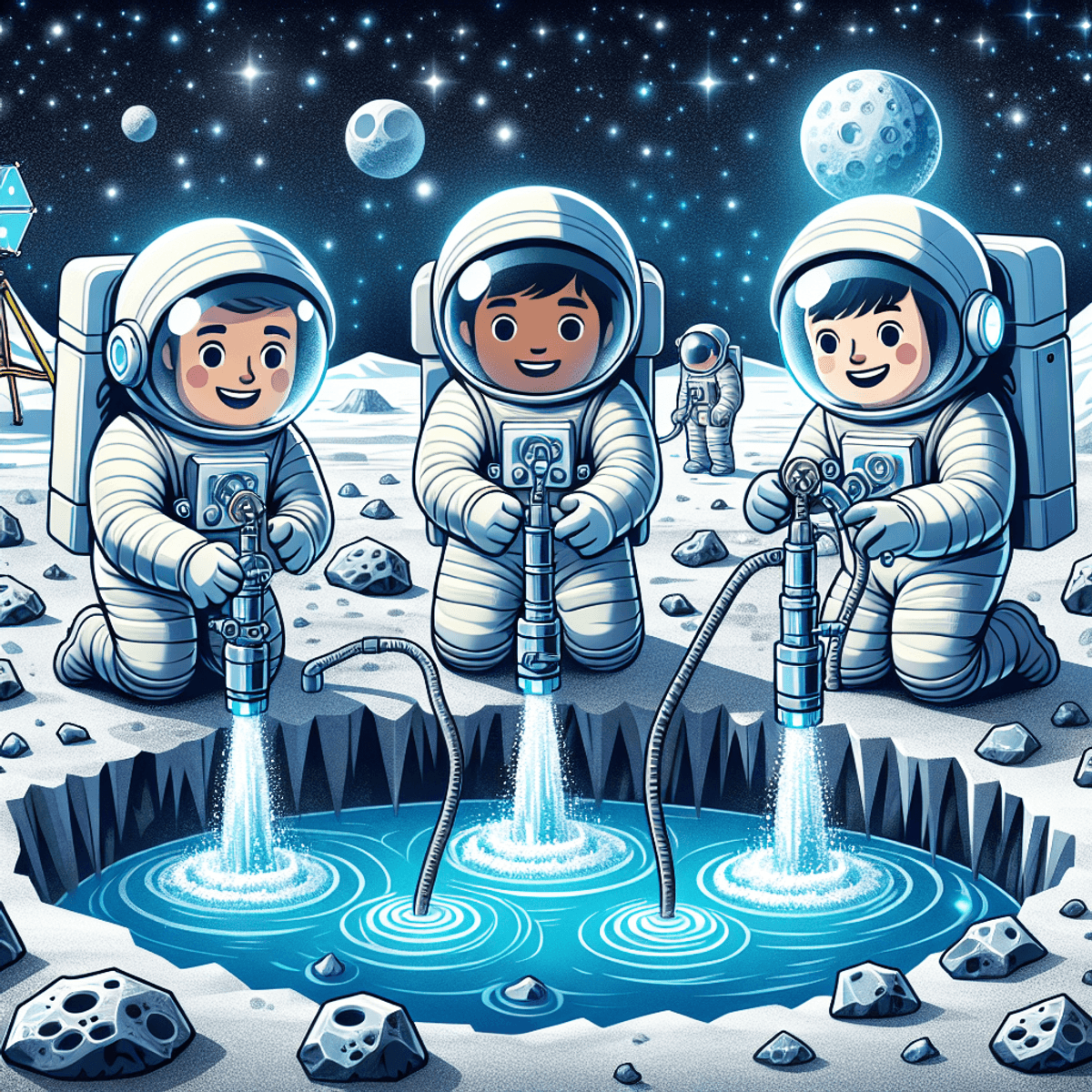Can We Drink Water on the Moon? Artemis Astronauts Have Some Surprising Ideas
Water is crucial for any lunar mission. The Artemis program, aiming to establish sustainable living on the moon, places a strong emphasis on producing drinking water on the moon. Innovative approaches are currently being explored to ensure astronauts have access to potable water, which is essential for their safety and mission success.
The Significance of Water on the Moon
Key Area for Exploration: Lunar South Pole
The lunar south pole stands out as a prime target for exploration due to its abundance of water ice. This region, constantly shadowed from the sun's rays, harbors vast deposits of ice within its craters. These frozen reservoirs are crucial for sustaining future missions and potentially serving as a resource hub.
Sustaining Life on Long-Duration Lunar Stays
Water is not just essential for drinking; it's vital for various life-support systems. When considering survival in space, water plays multiple roles, including:
- Hydration: Keeping astronauts hydrated during their stay.
- Oxygen Production: Breaking down water molecules to produce breathable oxygen.
- Radiation Shielding: Using water as a barrier against harmful cosmic radiation.
These factors highlight why ensuring a steady supply of potable water is paramount for long-term lunar habitation.
The Aqualunar Challenge: An Innovative Approach to Lunar Water Production
The Aqualunar Challenge is an exciting initiative that brings together the innovative minds from the UK and Canadian Space Agencies. This collaborative effort aims to crack one of space exploration's toughest nuts: producing liquid water on the moon.
Goals of the Aqualunar Challenge
- Technology Development: Innovating methods for generating potable water from lunar ice, ensuring that water produced is safe for astronaut consumption.
- Astronaut Safety: Designing systems that minimize risks, making sure that any water production technology deployed can withstand the harsh conditions of the lunar surface.
- Efficiency and Scalability: Creating solutions that are not only effective but also scalable for long-term lunar missions.
This challenge encourages teams to think outside the box, pushing boundaries to ensure astronauts have reliable access to one of life's most crucial resources.
Finalist Teams and Their Innovative Proposals
1. Lunasonic: Harnessing Ultrasound Waves for Ice Melting and Purification
Lunasonic technology offers a groundbreaking method to tackle the challenge of water production on the moon. By utilizing ultrasound waves, this approach aims to both melt and purify lunar ice, transforming it into potable water.
How it works:
- Ultrasound waves generate high-frequency vibrations that cause the ice to melt.
- The same vibrations help in purifying the melted water by breaking down contaminants.
Advantages:
- Efficiency: The use of ultrasound waves can potentially speed up the melting process, providing a quick supply of liquid water.
- Dual-functionality: Melting and purification happen simultaneously, making this method highly efficient.
Challenges:
- Energy Requirements: Ultrasound technology may demand significant energy, which could be a limiting factor given the constraints of lunar missions.
- Scalability: While effective on a small scale, scaling up this technology to meet the needs of an entire mission might pose difficulties.
Lunasonic's innovative approach could revolutionize how we think about sourcing water on the moon. As with any pioneering technology, it comes with its set of challenges that need addressing to ensure its viability in harsh lunar conditions.
2. RIPPLE: A Revolutionary Approach to Ice Vaporization and Pollutant Removal
RIPPLE technology takes a unique approach to lunar water production by vaporizing ice and separating pollutants, much like a salad spinner. This innovative method addresses the challenge of purifying water in harsh lunar conditions.
How It Works:
- Vaporizes ice to separate contaminants.
- Utilizes a spinning mechanism to filter out pollutants efficiently.
Effectiveness in Lunar Conditions:
- Designed to function effectively despite temperature extremes.
- Capable of managing dust contamination prevalent on the moon’s surface.
The ability of RIPPLE technology to adapt to such harsh environments makes it a strong contender among the finalist teams competing with their innovative technologies.
3. Ganymede's Chalice: Utilizing Solar Concentration for Water Purification
Ganymede’s Chalice is one of the standout technologies among the finalist teams, leveraging mirrors to concentrate sunlight directly onto contaminated water sources. This method purifies water by using the intense heat generated from focused sunlight.
Efficiency & Feasibility
The technology promises high efficiency due to its direct utilization of solar energy.
Potential Limitations
- Reliance on continuous sunlight: Limited functionality during lunar night cycles.
- Adaptability to lunar conditions: Mirrors must withstand extreme temperatures and potential dust contamination.
The innovative approach showcases a promising solution within the scope of lunar missions.
Overcoming Challenges in Creating Potable Water on the Moon
Turning lunar ice into drinkable water isn't as simple as melting and sipping it. Several obstacles need to be tackled head-on:
- Lunar regolith contamination: The moon's surface is covered in a layer of loose, fragmented material called regolith. This dusty, abrasive substance can easily mix with ice, making it difficult to extract pure water.
- Extreme temperatures: The moon experiences drastic temperature fluctuations, ranging from boiling hot during the day to freezing cold at night. These extremes complicate the process of maintaining a stable and efficient water production system.
Low-maintenance purification methods are crucial for long-term sustainability on the moon. Space conditions demand solutions that require minimal human intervention and can function reliably despite harsh environmental factors.
Future Prospects and Developments in Lunar Water Production Technologies
The competition among teams like Lunasonic, RIPPLE, and Ganymede's Chalice is heating up as they refine their innovative solutions. Each team's progress is closely monitored, with milestones set to be reached in the coming months. This ongoing research aims to address the practicalities of turning lunar ice into drinkable water.
1. Lunasonic
Current prototypes are being tested for efficiency and energy consumption. Expect updates on their ultrasound-based ice melting and purification system soon.
2. RIPPLE
Focused on optimizing its ice vaporization technology to handle lunar dust contamination effectively. Upcoming trials will test its performance under simulated lunar conditions.
3. Ganymede's Chalice
Engineers are fine-tuning solar concentration techniques to ensure consistent water purification during the lunar day-night cycle. Results from these optimizations are anticipated shortly.
As we approach 2025, NASA's selection process for Artemis mission partners will reveal which technologies are deemed ready for deployment on the moon. These advancements promise exciting developments in sustainable lunar living.
Conclusion
The dream of sustainable lunar living is becoming more tangible thanks to the relentless innovation in space exploration. Access to potable water resources beyond Earth’s atmosphere is one of the most critical hurdles, but these creative technologies from the Aqualunar Challenge finalists are paving the way.
Why This Matters
- Survival and Sustainability: Water is essential for human survival and crucial for long-duration lunar missions.
- Technological Innovation: These projects highlight how innovative thinking can lead to practical solutions.
What We Can Do
Encouraging continued efforts in developing these groundbreaking technologies is vital. Each step forward brings us closer to establishing a sustainable human presence on the moon and, eventually, beyond.
"Every drop counts when it comes to space exploration."
By supporting and investing in such initiatives, we inch closer to making lunar colonies a reality. So keep an eye on these developments as they unfold—exciting times are ahead for space enthusiasts and future moonwalkers alike!






Leave a comment